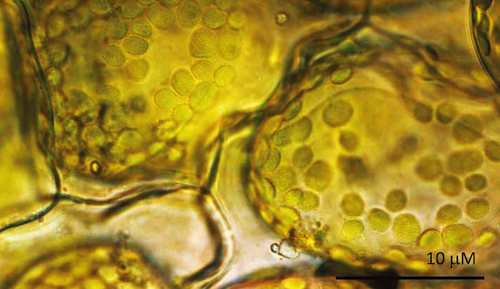Synbio Researchers Publish in Popular Science Magazine

Plant cells with many chloroplasts in each.
In a Danish science magazine, a group of scientists at Center for Synthetic Biology explain how their project of re-engineering photosynthesis will make it possible to build a new kind of sustainable, solar-driven chemical industry.
In this article the authors describe the how the amount solar energy that the photosynthesis converts into chemical energy can be used for other things than making plants grow. The researchers show how they can reconstruct plant and algae cells into chemical factories producing anything from anti-cancer drugs, bioplastics or fuel from sun light, CO2 and water.
It starts by realizing the potential in the highly specialized enzymatic-tools in plants belonging to the class cytochromes P450 (P450ies). These group of enzymes are responsible for producing a wide variety of natural compounds that we humans are depending on. E.g. the malaria drug arteminisin and the cancer-drug taxol.
But the plants that produce these compounds are either very rare or are growing very slowly, and the compounds are too complex to be produced with traditional chemical methods.
So to produce high quantities of these compounds, the scientists decided to move these enzymes from their native part of the cell to another part where the chemical energy abounds. I.e. the chloroplasts membrane, home to the cell's "solar power plants", Photosystem I. To let the P450 enzymes have access to a substantial amount of energy, the scientists explain how they place them in close contact with the Photosystem I protein complex.
This concept has been proven, and further research will now go into pairing the photosystem I with different combinations of P450 enzymes, to be able to produce high-value compounds in these re-engineered cells.
Towards the end of the article, the authors nicely lay out the grand vision for building a sustainable society using a synthetic biology approach to photosynthesis:
"The combination of photosynthesis and P450s is just one example of building systems with new functions, when you combine biological components in completely new ways. Without a doubt, photosynthesis will become a key player to have on our team, if we want a society with sustainable production of high-value compounds as well as materials and energy".
Professor and leader of the Lightdriven Biosynthesis workgroup at Center for Synthetic Biology Poul Erik Jensen wrote the four-page feature article along with Associate Professor Helle Juul Martens and two of his students; PhD-student Lærke Münter, and MSc. Bibi Ziersen. Other contributors to the research describe were: Professor Birger Lindberg Møller, postdoc Agnieszka Zygadlo Nielsen, PhD Kenneth Jensen and PhD student Thiyagarajan Gnanasekaran.
Read more about Agnieszka Zygadlo Nielsen's research here:
https://synbio.ku.dk/research/researcher_profiles/agnieszka_zygaldo_nielsen/
Read more about Poul Erik Jensen's research here:
https://synbio.ku.dk/research/researcher_profiles/poul_erik_jensen/
Read more about Birger Lindberg Møller's research here:
https://synbio.ku.dk/blm
